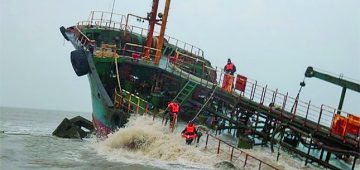CMA CGM is to install Winterthur Gas & Diesel Ltd. (WinGD) X-DF engines in its 9 new 22,000 TEU capacity ships. These low-speed X-DF dual-fuel 92cm bore engines with low-pressure gas admission are of the 12-cylinder X92DF variety. The newbuilds ordered by CMA CGM will be built at the yards of Hudong-Zhonghua Shipbuilding (Group) Co., Ltd. and Shanghai Waigaoqiao Shipbuilding Co. Ltd. and are due to enter service in 2020 on routes between Asia and Europe. The 2-stroke 12X92DF engines will be rated 63,840kW at 80 rpm, making them the most powerful gas and dual-fuel engines ever built. WinGD has so far received more than 75 orders for X-DF engines since their introduction to the market at the end of 2013. Besides being popular for application in LNG carriers for main propulsion, the number of orders received for cargo ships operating on LNG increased substantially in 2017, with over 25 orders received in 2017 at the time of writing.
Containership’s first (of four) LNG-fuelled, 1,368 TEU capacity container vessels was launched at the Wenchong Shipyard in China on 4th November. The Containerships Nord’s launch was quickly followed by the keel laying of the second vessel, which is now under construction. The block production for the second vessel was almost finished at that time and 148 blocks had been accepted for assembly. The main engine testing commenced from the end of November. The steel for the third vessel was cut in May 2017 and for the fourth vessel in September 2017. In total, €7 million was granted to Containerships, of which EUR 10 million was allocated for four LNG vessels for North and Baltic Sea operations and EUR 7 million for the upgrade of the port infrastructure and development of cargo handling capacity in the ports of Helsinki, Rotterdam and Teesport.

COSCO Shipping’s 10,036 TEU capacity containership CSCL Yellow Sea (116,568gt/2014 built) was detained after colliding with a quayside and damaging a crane at Dekheila Port in Alexandria, Egypt on 12th November. The ship was reportedly approaching the port at high speed when the collision occurred. Generally container cranes should be stowed clear of the quay when ships are arriving/departing but this is not always the case and mishaps occur.
Sign-up today to read the full article!
Simply click below to sign-up and read the full article, as well as many others, instantly!






Comments
Sorry, comments are closed for this item